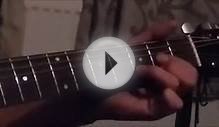
Simple guitar lessons for Beginners
If you want to play guitar but don’t know where to start you are in the right place. This video will show you how to play your first real song on the guitar in five easy to follow steps. These steps include Guitar Fundamentals (How To Hold The Guitar and The Basic Numbering Systems For The Guitar), Basic Strumming, Basic Chord Shapes, Changing Chords Smoothly, and Your First Song.
Step number one is “Guitar Fundamentals”. The two fundamentals we will cover here are how to hold the guitar and the three basic numbering systems for the guitar. There are several ways that you can hold the guitar, but we will just cover the most common one in this lesson. The casual method of holding the guitar is when you simply place the guitar on your right leg, if you are right handed, and pull it in close to your body. The temptation as a new guitar player is usually to let the guitar slide down your leg so you can see what is going on. Try to avoid that. Pull the guitar in close to your body and sit up straight.
The three basic numbering systems for the guitar cover the frets, the fingers, and the strings. Frets are the metal strips that go along the neck of the guitar. The one farthest to your left, if you are right handed, is the first fret. The next one to the right of the first one is the second and so on. This is very simple but it’s important to understand for when you start learning chords and scales.
The numbering system for the fingers on your fretting hand is very simple but also important. Your index finger is your first finger, your middle finger is your second finger, you ring finger is your third finger, and your pinky is your fourth finger. Again, super-simple but really important for when you start learning where to put your fingers to make chords.
The final numbering system is for the open strings of the guitar. The thinnest string is the first string and the thickest string is the sixth string. Pretty easy to remember.
Step number two is “Basic Strumming”. Lot’s of students ask what type of pick they should use. I would recommend starting with a standard shaped medium thickness pick, about .73mm. From there you can try thicker or thinner picks and decide what you like for yourself. If you don’t want to use a pick you don’t have to. You can simply make the strumming motions with your thumb or thumb and index finger.
How you hold the pick, the pick grip, is pretty subjective. You can start with a pretty generic pick grip and experiment from there. Put the pick on the pad of your thumb and then come down on it with you index finger. Try to stay relaxed. Many newer guitarists have trouble holding on to the pick when strumming. If that is the case you can always try holding on to the pick with your thumb and first and second fingers. That just gives you a little more control and stability. Experiment with different pick grips and see what works for you.
Now that you have a basic pick grip working we need to talk about some basic strumming technique. The best analogy I’ve heard for this is to pretend like you have a feather stuck to your pinky with some honey. Pretend like you are just trying to shake that feather off. The motion of your wrist and your elbow working together is a great mechanic to think about when strumming. It helps you stay relaxed and keeps you from using just your elbow for the motion. Take your pick and try a few relaxed downstroke motions. Be sure to think about the honey and feather analogy.
Upstroke strumming can be pretty challenging at first. I have a couple of tips for you that will make this a bit easier. First of all, when you do an upstroke you don’t have to strum through all six strings even if the chord you are playing uses all six strings. Most people generally only hit the top 3-5 strings with their upstrokes. Tip number two is to only use as much of the pick as you need to strum at the appropriate volume you need for the song you are playing. If you dig too much of the pick into the strings you will probably have trouble getting it through all the stings. Try some relaxed upstrokes and be sure to keep the previous two tips in mind.
Let’s talk about counting now. Most songs are in four-four time. That just means that there are four beats for each measure of music. Think about when you hear a drummer count of a song “1 2 3 4”. Those numbers are the beat of the music. Now try counting out loud “1 2 3 4” and strumming with downstrokes on the “1” of each cycle as you count. When you do this you are strumming whole notes. Now try strumming on every number as you count using downstrokes or alternating down and upstrokes. If you strum on every number you will be strumming quarter notes.
The next step is “Basic Chord Shapes”. You will be learning an E minor chord and a D2 chord. To start things out stick your fretting hand out with your palm up like you are simply holding an apple. This is a good posture to think about when making chords. Put your hand up to the neck of the guitar and place your thumb on the back of the neck. Don’t kink your wrist too far one way or the other.
To play your E minor chord put your 2nd finger on the 2nd fret of the 5th string and your 3rd finger on the 2nd fret of the 4th string. Make sure your fingers are right behind the fret and that you are coming down right on the very tips of your fingers. You will also want to make sure that your fingers are not brushing up against the neighboring strings and muting them. You can check out the diagram for this chord right here on this page. Once you have the chord in place strum each individual string slowly to make sure the chord is clean and clear.
The second chord that you need to learn is a D2 chord. Place your 1st finger on the 2nd fret of the 3rd string and your 3rd finger on the 3rd fret of the 2nd string. Again, make sure your fingers are right behind the frets, that you are coming down right on the very tips of your fingers, and that your fingers are not brushing up against the neighboring strings. The diagram for this D2 chord is on this page. Strum each string slowly to make sure the chord is clean and clear.
YOU MIGHT ALSO LIKE



Share this Post
Related posts
Acoustic Blues Guitar Lessons for Beginners
Every guitar player experiences a major turning point early on in their education. After the requisite, and often times…
Read MoreYouTube Guitar lessons for Beginners acoustic
How to Get the Most from Your YouTube Learning Experience Want to improve your playing, but don’t have money or time to dedicate…
Read More










